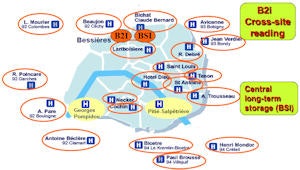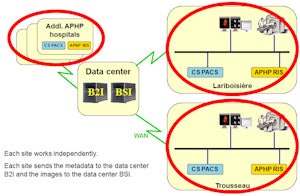
The enterprise-wide PACS project covering Paris' vast public hospital network is continuing to move ahead. Ongoing work is being done to streamline the multisite operation of the Assistance Publique Hôpitaux de Paris (AP-HP) group, allowing easy cross-reading between hospitals and fast reporting from PACS, while protecting patient privacy, according to Dr. Daniel Reizine, a radiologist at the Lariboisière Hospital and the coordinator of the project.
This question-and-answer article provides an update on the initiative and looks at the remaining challenges ahead.
AuntMinnieEurope.com: Can you provide some background information about public hospitals in Paris?
 Dr. Daniel Reizine, from the Lariboisière Hospital in Paris, is the PACS coordinator at the AP-HP.
Dr. Daniel Reizine, from the Lariboisière Hospital in Paris, is the PACS coordinator at the AP-HP.
Dr. Daniel Reizine: The AP-HP is the main public hospital system of the city of Paris and its suburbs. It was created in 1849 and is the largest public hospital system in Europe. It has a total of 22,000 beds, about two-thirds of which are for acute care, and it provides healthcare, teaching, research, prevention, education, and emergency medical services.
More than 90,000 staff work at AP-HP's 47 hospitals, including 15,000 medical doctors. Each year there are about 1.1 million hospitalizations, 5 million consultations, and 1 million emergency visits. About 2 million radiological examinations are performed annually on equipment that includes 36 CT scanners, 31 MR units, seven PET/CT systems, and 37 SPECT systems. The modalities are linked to 37 RIS and are located mostly in 31 radiology departments and 16 nuclear imaging sections.
AME: What important recent developments have occurred in your PACS project?
DR: Previously we had 20 independent sites, each with its own local PACS, storage, and backup system. We have now installed in the AP-HP data center one central storage unit with capacity to hold imaging studies for the next five years. Since 2005, the Carestream PACS at AP-HP has accumulated more than 8 million studies and 400 TB of data, now stored at the data center. About 150,000 new studies are added to the central storage each month. Each site keeps locally the last two years of data online and updates the central database at the data center with every study details within less than five minutes of its completion. This makes the central database (Oracle 11G) a registry for all radiology studies done at any of the 20 sites, and allows the creation of global worklists that may be used for specialty and cross-site reading. In the first two years, each study is stored with three copies: one local online, one local backup, and one at the datacenter. After two years, two copies of each study are stored (local backup and data center).
The new architecture is much more robust, with excellent fail-safe capabilities for the overall AP-HP enterprise PACS. It also means that each site can work independently of the data center. The AP-HP data center hosts most of the applications in AP-HP. A fast network between the hospitals allows loading images from the data center nearly as fast as from the local storage unit.
PACS in APHP - 2012

Click image to enlarge.
AME: What steps have you taken to ensure the continued security of data?
DR: We have implemented an approach called "Layer-based Authentication and Access Control." Using a local and central active directory, users can access data that reside anywhere across the AP-HP domain -- a local site, remote site, and data center -- with same user identity.
Each local site within AP-HP enforces its own security policy on local users that usually enables them to access all data within the local site. There is a more strict access control policy for obtaining data from a remote site and the data center. To access data from a remote site, users have to be assigned with dedicated permissions and must supply additional unique patient-specific details to be able to view the data.
AME: You mention that you have been implementing "reporting from PACS." Can you elaborate here and provide some details about how this concept works?
DR: It involves generating the report directly into the PACS, using speech recognition, templates, and all the steps usually done with RIS workflow.
Reporting from PACS significantly enhances the radiologists' workflow. In most places, radiologists work with three different systems to create a report: PACS, RIS, and a dictation system. With reporting from PACS, they use the PACS only. The PACS has a two-way interface with the RIS that eliminates the need of the radiologist to use the RIS for his reading and reporting workflow. The "worklist" is now done generated by the PACS, and the reading and reporting flow are all driven by the PACS.
The report is generated by speech recognition, and dictation-transcription workflow also is possible to support certain scenarios. Report templates are used to facilitate the creation of reports. There are system-level templates that are shared by all radiologists and also private templates that are created by each radiologist.
The templates are automatically matched to the study being read, according to the DICOM information. When a radiologist loads a study and opens the report editor, the corresponding template is already displayed. Prior reports are viewed on the PACS. Final reports are sent to the RIS for updating its database. This eliminates the need for an extra validation step that was needed with the old AP-HP reporting system. Another advantage of reporting from PACS is that key images as well as measurements, currently stored only on the modality, can now be inserted into the report.
Design Goal for APHP Architecture
','dvPres', 'clsTopBtn', 'true' );">
Click image to enlarge.
AME: What access to medical data/images in the AP-HP patient's file do you allow from outside AP-HP, especially for general practitioners and specialists?
DR: We do not allow access from outside AP-HP. Our network is private, and for the time being we do not want to have to manage thousands of external users. To communicate with hospitals outside of AP-HP, we use a DICOM server, which is located in our demiliterized zone (DMZ), through which we transmit the studies from the local AP-HP PACS. From this server in the DMZ, we can forward the studies to the same-type server in the outside hospital. To achieve encryption and remote node authentication, DICOM connection to the DMZ can be established over an secure sockets layer (SSL). We have also started to communicate by secure email systems that can handle the report
AME: How much interaction do you have with other structures, particularly La Région sans Film (RSF)?
DR: For the time being, we do not have interaction with La Région sans Film, whose main goal is to install PACS in all the hospitals in l'Ile de France that do not have a digital system. We do plan to start having active discussions with RSF in the future.
AME: What other plans do you have for the future development of PACS at AP-HP?
Our main priorities for the future are to integrate the two Agfa PACS, installed in two AP-HP hospitals, into the Carestream system; update the local PACS setup of the 20 sites (which is about six years old); to install reporting from PACS in the 20 sites; install a full Web image distribution system from Carestream across AP-HP, and move the long-term local backup to the data center. This is certainly going to keep us busy!



















